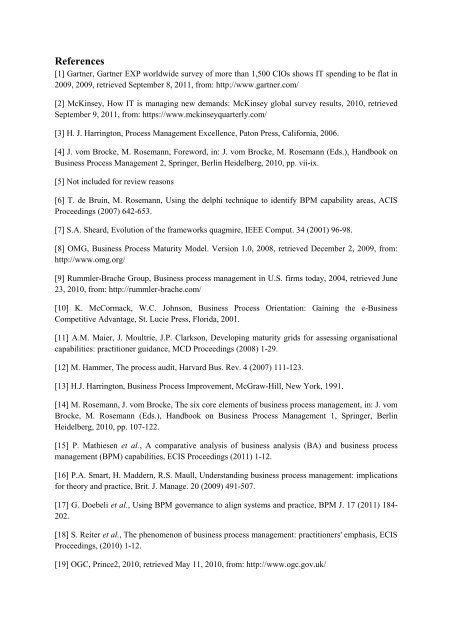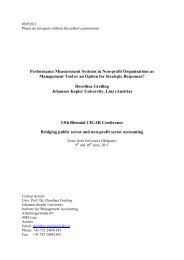A theoretical framework and classification of capability areas
A theoretical framework and classification of capability areas
A theoretical framework and classification of capability areas
You also want an ePaper? Increase the reach of your titles
YUMPU automatically turns print PDFs into web optimized ePapers that Google loves.
References<br />
[1] Gartner, Gartner EXP worldwide survey <strong>of</strong> more than 1,500 CIOs shows IT spending to be flat in<br />
2009, 2009, retrieved September 8, 2011, from: http://www.gartner.com/<br />
[2] McKinsey, How IT is managing new dem<strong>and</strong>s: McKinsey global survey results, 2010, retrieved<br />
September 9, 2011, from: https://www.mckinseyquarterly.com/<br />
[3] H. J. Harrington, Process Management Excellence, Paton Press, California, 2006.<br />
[4] J. vom Brocke, M. Rosemann, Foreword, in: J. vom Brocke, M. Rosemann (Eds.), H<strong>and</strong>book on<br />
Business Process Management 2, Springer, Berlin Heidelberg, 2010, pp. vii-ix.<br />
[5] Not included for review reasons<br />
[6] T. de Bruin, M. Rosemann, Using the delphi technique to identify BPM <strong>capability</strong> <strong>areas</strong>, ACIS<br />
Proceedings (2007) 642-653.<br />
[7] S.A. Sheard, Evolution <strong>of</strong> the <strong>framework</strong>s quagmire, IEEE Comput. 34 (2001) 96-98.<br />
[8] OMG, Business Process Maturity Model. Version 1.0, 2008, retrieved December 2, 2009, from:<br />
http://www.omg.org/<br />
[9] Rummler-Brache Group, Business process management in U.S. firms today, 2004, retrieved June<br />
23, 2010, from: http://rummler-brache.com/<br />
[10] K. McCormack, W.C. Johnson, Business Process Orientation: Gaining the e-Business<br />
Competitive Advantage, St. Lucie Press, Florida, 2001.<br />
[11] A.M. Maier, J. Moultrie, J.P. Clarkson, Developing maturity grids for assessing organisational<br />
capabilities: practitioner guidance, MCD Proceedings (2008) 1-29.<br />
[12] M. Hammer, The process audit, Harvard Bus. Rev. 4 (2007) 111-123.<br />
[13] H.J. Harrington, Business Process Improvement, McGraw-Hill, New York, 1991.<br />
[14] M. Rosemann, J. vom Brocke, The six core elements <strong>of</strong> business process management, in: J. vom<br />
Brocke, M. Rosemann (Eds.), H<strong>and</strong>book on Business Process Management 1, Springer, Berlin<br />
Heidelberg, 2010, pp. 107-122.<br />
[15] P. Mathiesen et al., A comparative analysis <strong>of</strong> business analysis (BA) <strong>and</strong> business process<br />
management (BPM) capabilities, ECIS Proceedings (2011) 1-12.<br />
[16] P.A. Smart, H. Maddern, R.S. Maull, Underst<strong>and</strong>ing business process management: implications<br />
for theory <strong>and</strong> practice, Brit. J. Manage. 20 (2009) 491-507.<br />
[17] G. Doebeli et al., Using BPM governance to align systems <strong>and</strong> practice, BPM J. 17 (2011) 184-<br />
202.<br />
[18] S. Reiter et al., The phenomenon <strong>of</strong> business process management: practitioners' emphasis, ECIS<br />
Proceedings, (2010) 1-12.<br />
[19] OGC, Prince2, 2010, retrieved May 11, 2010, from: http://www.ogc.gov.uk/

















